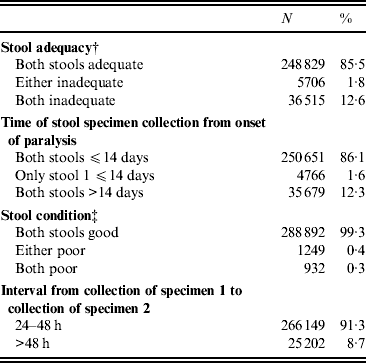Collection of two stool specimens 24 to 48 hours apart in the first 14 days following the onset of paralysis packed on ice fill in afp case investigation form include epid not usual nhls request form afp cif is packed with sample serves as request for the test send specimen to nicd 60 day follow up where indicated incompletely investigated cases classification of cases by npec.
Afp surveillance stool sample collection.
The adequate stool collection rate ranged from 33 3 7 21 to 72 5 29 40.
By testing stool samples collected from children suffering acute flaccid paralysis the clearest symptom of the virus as well as samples taken from sewage water we are able to find the poliovirus wherever it is hiding.
Our results indicated that the country performed well above the target throughout the study period.
Collection transport and reporting results of stool specimen when to collect stool specimen from a case of afp.
According to the who specified national targets for afp surveillance at least 80 of stool specimens must arrive at the laboratory within 72 hours of collection 35 37.
Surveillance is one of the main pillars of the polio eradication initiative.
Stool specimens must be collected within 14 days of onset of paralysis to maximize the chances of isolating poliovirus.
The first specimen should be collected at the time of the case investigation.
In case samples cannot be collected within 14 days the specimens should still be collected up to 60 days of paralysis onset.
In order to maximise the ability of surveillance to rapidly detect imported cases the established performance indicators for afp surveillance requires that all cases of afp be notified and investigated as prospective polio cases including the collection of 2 stool samples 24 hours apart and within 14 days of the onset of paralysis 8 9.
2 stool specimens must be collected from every afp case.
Highly sensitive surveillance for acute flaccid paralysis afp including immediate case investigation and specimen collection are critical for the detection of wild poliovirus circulation with the ultimate objective of polio eradication.
Who has specified timeliness of transportation of stool specimens for afp surveillance at least 80 of stool specimens to arrive at the polio laboratory within 72 hours of sending from the field.
Acute flaccid paralysis afp surveillance is the primary means of poliovirus detection supplemented by environmental surveillance i e the collection of sewage samples for poliovirus testing to identify poliovirus circulation in the absence of detected afp cases.
The annual proportion of afp cases with non polio enterovirus findings varied widely across the study period.










